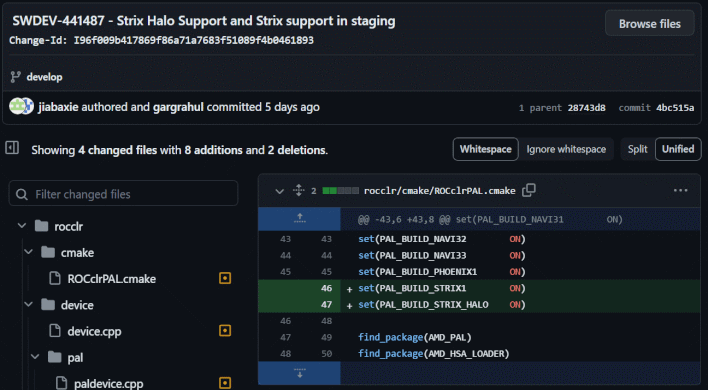AMD Strix Halo APUs Are Coming, May Flex Up To 16 Zen 5 Cores, 40 RDNA 3.5 CUs
This confirmation comes in the way of an update to the Compute Language Runtimes (CLR) of AMD's ROCm compute platform. The update was authored by an AMD employee, and it doesn't change much. Primarily, the purpose of the update seems to be as described in the comment: "Strix Halo Support and Strix support in staging". In other words, the patch simply adds Strix Point (referred to as "STRIX1") and Strix Halo support to CLR.

If you're lost, let us explain. AMD's next-generation mobile APUs are codenamed Strix Point. Just like Phoenix was called Phoenix Point in some documents, we also see "Strix" by itself used as the name in some places, so don't be surprised if you see that. Strix Point is supposedly going to sport up to twelve Zen 5 CPU cores, an RDNA 3.5 GPU of some potency, and an XDNA 2-based NPU with 45-50 TOPS of AI throughput. Essentially, a successor to Phoenix, but with some mix of standard Zen 5 and dense Zen 5c cores.
Strix Halo is purportedly a new class of processor that really hasn't been seen in the PC market. It's much closer to something like Apple's M-series processors, or the chips found in a game console. It's reported to come equipped with the same 45-50 TOPS NPU while raising the core count to 16 Zen 5 CPU cores, and increasing the GPU to a full twenty RDNA 3.5 WGPs. That's 40 compute units; a full 2,560 double-wide shader processors.

To serve this massive GPU, you'll need major memory bandwidth, and Strix Halo supposedly supports a 256-bit LPDDR5X memory interface. That's still considerably less bandwidth than is possible with something like GDDR6, but the lower-latency system RAM will keep performance speedy on desktop tasks. Paired with blazing 8.5 GT/s LPDDR5X memory, such a chip could achieve about 275 GB/sec of memory bandwidth—more than enough for games in 1080p or 1440p resolution, and comparable to the GeForce RTX 4060 or Radeon RX 7600 XT.
That wide memory bus means that these parts won't slot into standard Socket AM5 motherboards, and will instead require bespoke boards. So saying, you're looking at fancy laptops like the Macbook Pro as well as small-form-factor game systems. It's easy to imagine something like an Ayaneo Retro Mini PC AM01 packing a Strix Halo inside; PC based gaming consoles are all the rage right now thanks to the Steam Deck, and this would offer an entirely different tier of performance for a small stationary game system.

The new leak doesn't confirm any of these specifications, really, but the graphics device names are specified as "GfxIpLevel::GfxIp11_5", implying that these really are going to be "RDNA 3.5". Previous sources have stated that RDNA 3.5 is only coming to these integrated parts, so it's thought to be a minor revision of the RDNA 3 architecture, possibly cutting some of the cruft like the largely-unused AI accelerator blocks in that design.


